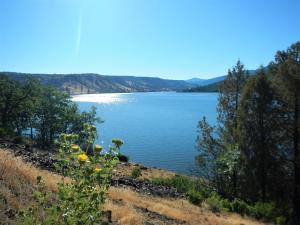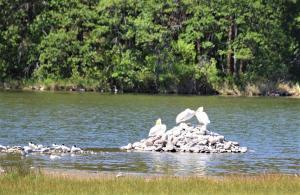
Copco Lake that is formed by the Copco 1 dam on the Klamath River has been the critical habitat for an amazing variety of species of flora and fauna, including numerous endangered and threatened species. Photo by William E. Simpson II

The Klamath River Canyon in the area of the existing lakes formed by the Klamath dams is critical habitat for numerous threatened and endangered species

The DOI cites the comments of dam engineers back in 1912 when they started building the Copco 1 dam at the site of natural 130-foot-tall lava dam and lake that existed for millions of years
Reasons being offered to regulators and legislators for removing Klamath River dams disregard both the survival of rare species and American democratic process
YREKA, CALIFORNIA, UNITED STATES, June 28, 2021 /EINPresswire.com/ -- The number of recently minted explanations for the proposed Klamath River dam removal project range from, a mythical salmon that somehow was able to surmount a 130-foot natural lava dam, to the costs of installing fish ladders.Both stories are highly questionable in light of the hard facts.
First examining the alleged salmon migration excuse for removing the dams:
According to a recently discovered 2006 U.S. Department of Interior (?DOI?) document titled; ?Historical Landscape Overview of the Upper Klamath River Canyon of Oregon and California?, there is an amazing diversity of co-evolved flora and fauna exist on and around the Klamath River Canyon. This is especially true in and around the two large fresh-water lakes formed by Copco 1 Dam and Iron Gate Dam.
The 2006 DOI document explains that; a large lava flow millions of years ago, called a ?lava reef?, created a natural dam on the Klamath River at site of the present-day Copco 1 dam.
The area that was studied in the 2006 DOI document is seen in the image titled ?Study Area?.
This naturally formed lava dam was 130-feet tall and blocked the Klamath River creating a natural lake that was about 1-mile wide and 5-miles long. That natural 130-foot-tall dam stood for millions of years, and arguably in times past, that dam prevented fish migration past that point on the Klamath River. So the statement that there was a migration of salmonoids 'since time immemorial' is questionable.
Remnants of that natural lava dam and lake were still in place at the time of the construction of the Copco 1 dam in 1912.
When the Copco 1 dam was constructed, it took advantage of the ancient lava reef structures. Engineers built the 132-foot-tall cement dam between and upon a basalt (lava) reef. The remnants of that reef, still some 35 feet high are now under the water of the Copco Lake. (See image titled: Discussion of ancient lake and lava reef)
Second excuse; the costs and reduced profits related to re-licensing the hydroelectric dam and fish ladders:
According to an article in the Feb 16, 2012 edition of the Klamath Falls newspaper Herald and News:
?PacifiCorp has proposed removing the dam. Relicensing the facility wouldn't be feasible because it would require adding costly fish ladders that would reduce the dam's power potential, said PacifiCorp spokesman Bob Gravely.
Behind the dam is Copco Reservoir No. 1 (aka: ?Copco Lake?). About 300 people live on the banks of the recreational lake.?
According to the quote from Pacific Corp?s spokesman, it seems profitability and costs are the reason that Cocpo 1 dam should be removed.
Interestingly, Mr. Gravely makes no mention of salmon migration as the main reason for dam removal, only money.
Furthermore, he only mentions one aspect of the all-important 'beneficial uses' of the lake. 'Recreation' is one of several beneficial uses that are cited in the Klamath Basin Compact Act by Congress, which states (https://ballotpedia.org/Klamath_River_Compact):
"The major purposes of this compact are, with respect to the water resources of the Klamath River Basin:
To facilitate and promote the orderly, integrated and comprehensive development, use, conservation and control thereof for various purposes, including, among others: The use of water for domestic purposes; the development of lands by irrigation and other means; the protection and enhancement of fish, wildlife and recreational resources; the use of water for industrial purposes and hydroelectric power production; and the use and control of water for navigation and flood prevention."
"To further intergovernmental cooperation and comity with respect to these resources and programs for their use and development and to remove causes of present and future controversies by providing (1) for equitable distribution and use of water among the two states and the Federal Government, (2) for preferential rights to the use of water after the effective date of this compact for the anticipated ultimate requirements for domestic and irrigation purposes in the Upper Klamath River Basin in Oregon and California, and (3) for prescribed relationships between beneficial uses of water as a practicable means of accomplishing such distribution and use..."
Clearly, in the fall when fish migrations are triggered by rainfall, the added water flowing in the Klamath River above summer flow then allows for timely spilling of excess water into fish ladders, if they existed. So it seems this is yet another unsupported excuse given that, in the summer when there is less water, electricity is nevertheless produced without complaints from Mr. Gravely or Pacific Corp.
Science informs us that physical and geographic barriers between evolving species create evolutionary differences. This evolutionary process is called allopatric speciation.
And we now know for a fact that such a ?barrier?, the 130-foot-tall natural lava dam, existed for millions of years, and up to some period prior to the installation of the man-made Copco 1 dam in 1912.
Excerpt from Biology Dictionary:
?Allopatric speciation is speciation that happens when two populations of the same species become isolated from each other due to geographic changes. Speciation is a gradual process by which populations evolve into different species. A species is itself defined as a population that can interbreed, so during speciation, members of a population form two or more distinct populations that can no longer breed with each other.?
Undisputed geology and evolutionary science warn that; removing the dam at Copco 1 might create a new environmental and ecological problem with extensive, long-term inter-species repercussions.
"Removing the dams could allow the carnivorous Redband trout to move freely downstream. And if that happened, the Redband trout would prey upon the smaller trout in the lower Klamath River as well as juvenile Salmon and Steelhead" said Richard Marshall, President of the Siskiyou County Water Users Association.
Benefit to salmonids is uncertain, as pointed-out during the 2020 California Water Law Symposium by Paul Weiland, lawyer for Siskiyou County, who said the following:
?The sole justification for dam removal is to improve the lot of salmonids, and I would say that looking at the reports that were done by the Department of the Interior in 2010-12 time-frame, that we have hope that the salmonids will return, but we do not have good scientific basis for that hope,? said Mr. Weiland. ?There were two independent science reports and the panelists said, ?we are optimistic, we are hopeful, but this is highly uncertain.? In fact , it may be the case that we could go through this effort, and other things could happen that we don?t anticipate, which is the history of environmental law in the United States. For example, predation could eclipse some of those benefits.?
Copco Lake and Iron Gate Lake together hold about 45-billion gallons of fresh water. The dynamically complex lake-based fresh water ecosystem that has evolved over the past millions of years is robustly diverse and contains numerous threatened and endangered species of flora and fauna.
The 2006 DOI document cites a mere sampling of the amazing biodiversity:
The flora:
?The Upper Klamath River Canyon is a setting with a wide diversity of plant species. The area's transition between Coast and Basin and the river corridor have contributed to the unique setting holding the variety of flora. Trees include willows, pines, ash, oak, cedar, juniper, alder and birch. Shrubs range from poison oak and sumac to dogwood, manzanita, honeysuckle, currant, mock orange, ninebark, plum, chokecherry, crabapple, snowberry, sagebrush (several varieties), and Oregon grape. Dozens of herbaceous plants grow in this region; they include seven species of orchids, more than twenty lilies, and several varieties of paintbrushes. Grasses, ferns, horsetails, and lichens are also indigenous to the region (Bureau of Land Management 2003 [2]: 127-140).?
Co-evolved fauna:
?Wildlife includes several mammals, birds, fish, amphibians, and reptiles. Although grizzly bears and wolves are now extinct, large game includes black bear, wild boar, black-tailed deer, mule deer, elk, and mountain lion. Smaller mammals range from beaver, ermine, and fisher to bats, river otter, foxes, squirrels, chipmunks, rabbits, shrews, woodrats, and voles. Twenty-three reptiles live in the area and include the western rattlesnake, garter snake, and pond turtle. Nineteen raptors, five game birds, eleven woodpeckers, more than two dozen water-associated birds, and several dozen land birds are at home in this setting. Fish resources include red band trout and rainbow trout.?
"The myriad of rare species in and around Copco and Iron Gate Lakes would largely collapse due to the loss of the habitat provided by the lakes and their freshwater shoreline ecosystems if these dams are removed", said William E. Simpson II, a naturalist who studies the wildlife in the area of Copco and Iron Gate Lakes.
This incredibly reckless dam removal project must be halted immediately until a full and honest Environmental Impact Report (EIR) and Environmental Impact Study (EIS) are completed by scientists who are not beholden to the profiteers and/or the consensus minority pushing for dam removal and ignoring the awful trade-off of the existing endangered and threatened species of flora and fauna for a settled law and insulting the American democratic process.
Richard Marshall
Siskiyou County Water Users Association
+1 530-468-4204
email us here
Visit us on social media:
Facebook



